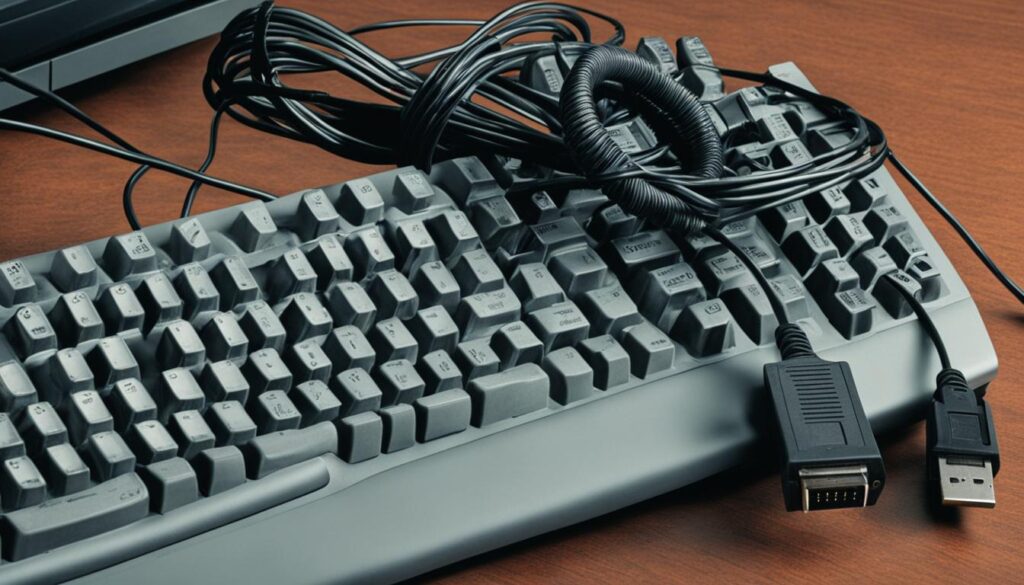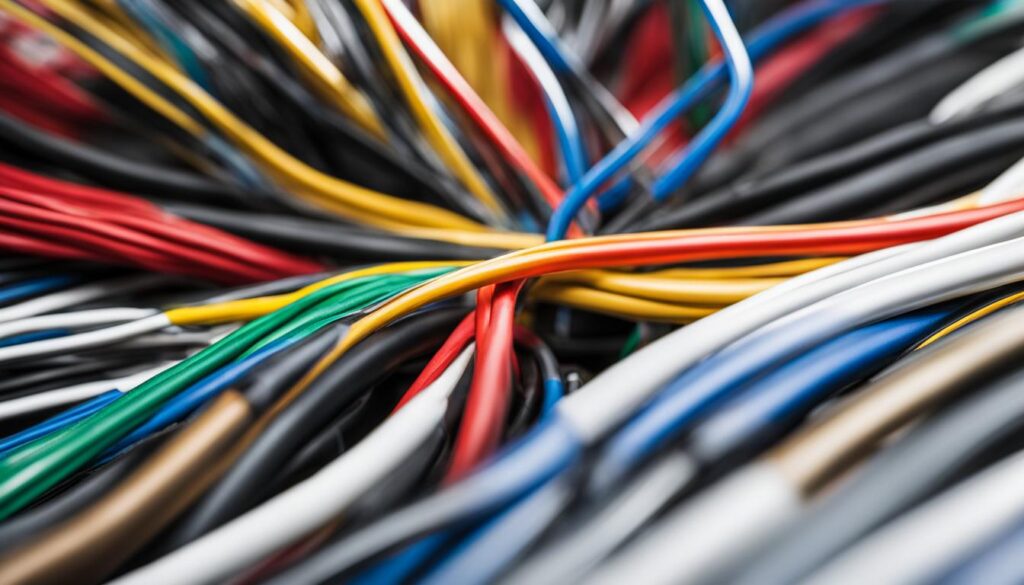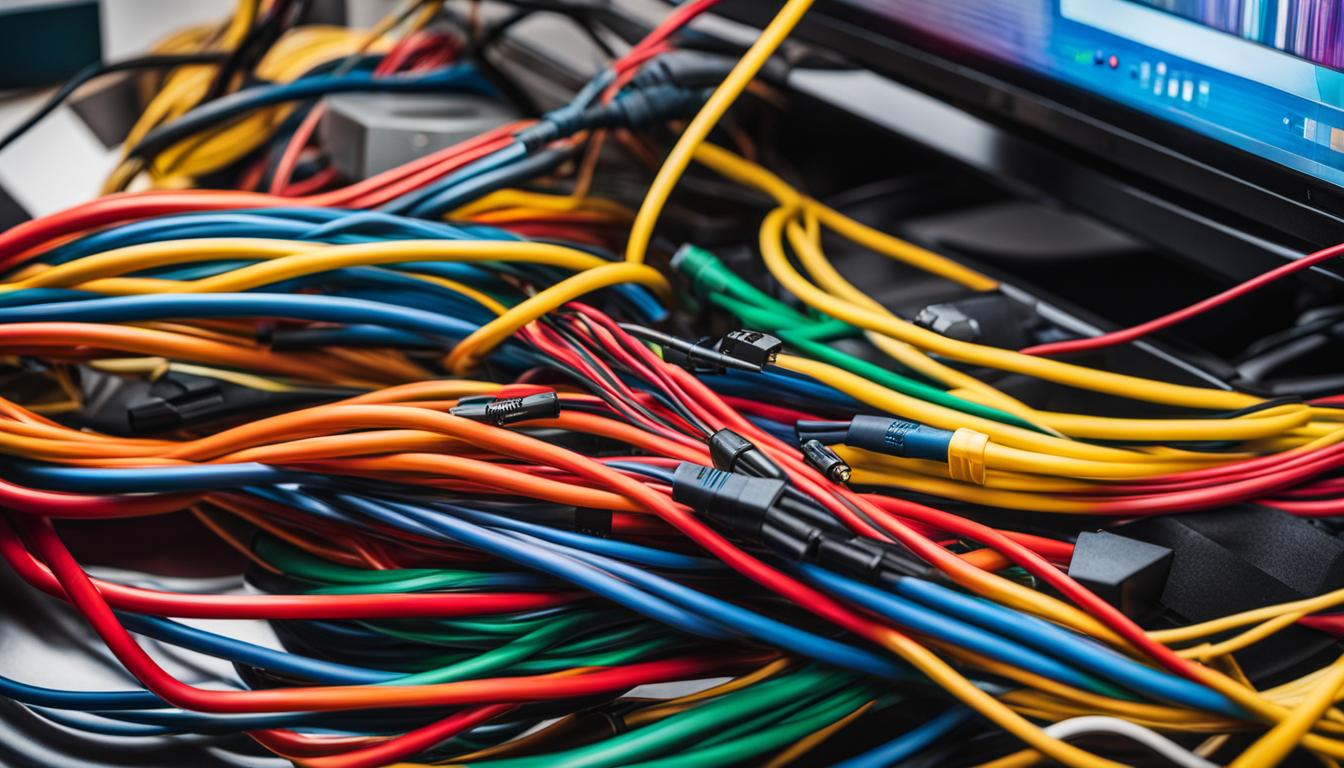In today’s digital age, information technology (IT) has become an integral part of our personal and professional lives. Whether you are browsing the internet, streaming videos, or working on important tasks, computers and other devices are at the core of these activities. But have you ever wondered what makes these devices function seamlessly and efficiently? The answer lies in computer cables, the unsung heroes of the IT world.
Computer cables are the lifelines that connect various devices to the computer system, enabling efficient data transfer and connectivity. They play a crucial role in transmitting power, audio, video, and data signals, making them essential components of IT setups. Without the proper cables, it would be impossible to establish reliable connections and effectively utilize the capabilities of information technology systems.
Contents
Key Takeaways:
- Computer cables are vital for efficient data transfer and connectivity in information technology setups.
- They play a crucial role in transmitting power, audio, video, and data signals.
- There are various types of computer cables, including DVI, HDMI, Ethernet, VGA, and USB cables.
- Other common computer cables include PS/2, 3.5mm audio, SCSI, and Thunderbolt cables.
- Power cables and data cables are important for the proper functioning of IT systems.
Types of Computer Cables
When it comes to setting up your computer system, you’ll need a variety of cables to ensure proper connections and functionality. Let’s explore some of the most common types of computer cables and their uses:
DVI Cable
The DVI (Digital Visual Interface) cable is specifically designed to transmit high-quality video signals from your computer to a monitor or display device. It provides a reliable and efficient connection, ensuring crisp and clear visuals for tasks such as video editing, gaming, and graphic design.
HDMI Cable
An HDMI (High-Definition Multimedia Interface) cable is a versatile cable that allows the transmission of both audio and video signals. It’s commonly used to connect devices like TVs, projectors, and gaming consoles to your computer. With an HDMI cable, you can enjoy high-definition picture and sound quality, making it perfect for home entertainment setups.
Ethernet Cable
For reliable and fast internet connectivity, an Ethernet cable is your go-to option. It enables wired network connections, allowing data to be transmitted between devices within a Local Area Network (LAN). Whether you’re gaming, streaming, or working on a shared system, Ethernet cables ensure stable and uninterrupted internet access.
VGA Cable
Although older in technology, VGA (Video Graphics Array) cables are still commonly used to connect older monitors and computers. They transmit analog video signals and are ideal for basic display needs. VGA cables are a cost-effective solution when modern display interfaces, such as HDMI or DVI, are not available.
USB Cable
USB (Universal Serial Bus) cables are incredibly versatile and can connect a wide range of peripherals to your computer system. Whether it’s a keyboard, mouse, printer, or external storage device, USB cables provide the necessary data transfer and power supply. USB cables come in various versions, with the latest being USB 3.0 and USB-C, offering faster data transfer speeds and improved power delivery.
Here’s a table summarizing the different types of computer cables:
| Cable Type | Usage |
|---|---|
| DVI Cable | Connecting monitors and display devices |
| HDMI Cable | Transmitting audio and video signals |
| Ethernet Cable | Enabling wired network connections |
| VGA Cable | Connecting older monitors and computers |
| USB Cable | Connecting peripherals and devices |
Now that you have a better understanding of the different types of computer cables, you can ensure you have the right cables for your setup. Remember, the right cables not only provide reliable connections but also enhance the overall performance of your computer system.
Other Common Computer Cables
In addition to the aforementioned cables, there are other common computer cables that serve specific purposes. These cables are essential for connecting various devices and peripherals to the computer system. Let’s explore some of these cables:
PS/2 Cable

The PS/2 cable is used to connect keyboards and mice to the computer system. It provides a reliable connection for input devices, allowing you to interact with your computer seamlessly. With a PS/2 cable, you can type, navigate, and control your computer with ease.
3.5mm Audio Cable
The 3.5mm audio cable is a widely used cable for connecting headphones, speakers, and other audio devices to the computer’s audio output. Whether you’re listening to music, watching videos, or playing games, the 3.5mm audio cable ensures high-quality audio transmission, delivering an immersive sound experience.
SCSI Cable
SCSI cables are commonly used for connecting devices such as hard drives and tape drives in a parallel interface. They provide a fast and reliable connection for data transfer, making them ideal for demanding tasks that require high-speed data access and storage.
Thunderbolt Cable
Thunderbolt cables are relatively new and offer lightning-fast data transfer and video streaming capabilities. They enable the connection of peripheral devices to the computer system, particularly used with Apple displays and devices. With Thunderbolt cables, you can experience high-performance connectivity, unleashing the full potential of your devices.
The Importance of Computer Cables in Information Technology
Computer cables are an integral part of any information technology setup. They serve a crucial purpose in ensuring the smooth functioning of computer systems by providing both power and data connectivity.
Power cables are responsible for delivering the necessary electrical supply to the components of a computer, allowing them to operate efficiently. Without power cables, the computer would be unable to function, leading to a loss of productivity and interruption in workflow.
Data cables play a key role in facilitating efficient connectivity between different devices in a computer system. These cables enable the transfer of data signals, such as audio, video, and files, ensuring seamless communication and collaboration.
Efficient connectivity is essential in information technology as it allows for smooth data transfer, enhances productivity, and enables effective utilization of resources. With the appropriate computer cables, you can establish reliable connections, minimize disruptions, and maximize the capabilities of your IT infrastructure.
“Computer cables are like the lifelines of information technology. They ensure the constant flow of power and data, facilitating efficient communication and seamless operations.”
Investing in high-quality power cables and data cables is crucial to avoid system inefficiencies, data loss, and potential interruptions in workflow. By using reliable and durable cables, you can maintain a stable and efficient IT environment, ensuring that your systems perform optimally.
| Type of Cable | Function |
|---|---|
| Power Cables | Deliver electrical supply to computer components |
| Data Cables | Facilitate seamless data transfer between devices |

Power cables and data cables are the backbone of efficient connectivity in information technology setups. They ensure the smooth operation of computer systems, allowing for seamless communication and data transfer between devices.
Conclusion
In conclusion, computer cables are the cornerstone of information technology essentials. They serve as the vital connectors for seamless data transfer and efficient connectivity between different devices in a computer system.
From power cables that supply the necessary electricity to data cables that transmit audio, video, and data signals, each type of computer cable plays a specific role in ensuring the smooth functioning of information technology setups. Without the appropriate cables, establishing reliable connections and harnessing the full potential of technology would be impossible.
Investing in high-quality computer cables is crucial for a seamless and efficient information technology experience. By choosing the right cables, you can optimize data transfer speeds, enhance connectivity, and ensure the proper functioning of your IT systems. Whether it’s for your home office setup or a large-scale corporate network, reliable computer cables are an essential component for unleashing the power of your technology.
FAQ
What are computer cables?
Computer cables are essential components of information technology setups. They connect various devices, such as monitors, keyboards, speakers, and networking equipment, to the computer system, allowing for efficient data transfer and connectivity.
What are the types of computer cables?
Some types of computer cables include DVI cables for connecting monitors, HDMI cables for audio and video signals, Ethernet cables for wired network connections, VGA cables for older monitors, and USB cables for peripherals like keyboards and mice.
What are other common computer cables?
Other common computer cables include PS/2 cables for connecting keyboards and mice, 3.5mm audio cables for headphones and speakers, SCSI cables for parallel interface devices like hard drives, and Thunderbolt cables for connecting peripheral devices to the computer system.
Why are computer cables important in information technology?
Computer cables play a vital role in information technology setups by providing reliable connections for efficient data transfer and connectivity. Without the appropriate cables, disruptions in data transfer, loss of power, and overall system inefficiencies can occur.
Are computer cables essential for information technology?
Yes, computer cables are indeed information technology essentials. They enable the establishment of reliable connections and maximize the capabilities of information technology systems, ensuring smooth operations and efficient data transfer.




